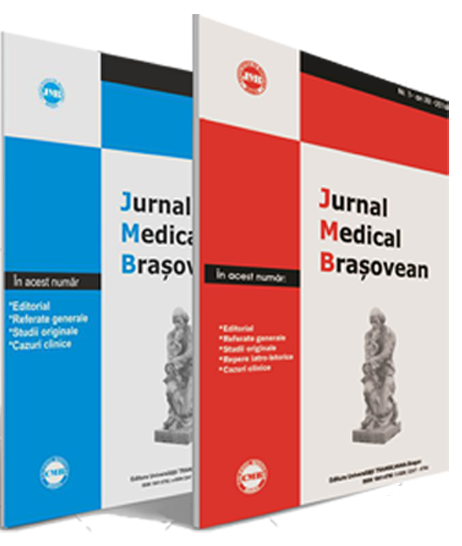Studiu de biocompatibilitate asupra acoperirilor de biosticlă – polimer pentru implanturi | [Biocompatibilitystudy of bioglass-polymernanocompositecoatings for implants]
DOI:
https://doi.org/10.31926/jmb.2023.2.3Keywords:
bioactive glasses, thin layers, matrix assised pulsed laser evaporation, implants, electrochemical studiesAbstract
Introduction: Bioactive glasses from the SiO2-Na2O-K2O-CaO-MgO-P2O5 system have special properties in contact with simulated human fluid, which makes them the ideal candidate for implantology. The main objective of the study: The realization of bioglass and polymer coatings for titanium implants, by the matrix-assisted pulsed laser evaporation method, which would increase their bioactivity and biocompatibility. Results and discussion: Thin films of bioactive glass and polymethyl methacrylate were deposited on Ti substrates, which were then analyzed by electrochemical methods to evaluate their behavior in contact with simulated human fluid. Electrochemical polarization studies show that titanium coated with the studied nanocomposites has a higher corrosion resistance than pure titanium, and the hydroxyapatite layer that grows later on the surface of the titanium implant also provides good protection for the implant. EIS analysis indicated that the film formed on titanium implants by immersing them in simulated body fluid is passive and bilayered, consisting of an inner barrier layer (polymer) and an outer porous layer (hydroxyapatite), which facilitates osseointegration. Conclusions: The results of in vitro studies on titanium implants coated with thin layers of bioactive glass and polymer recommend them as bioactive and corrosion-free and can be used safely.
Rezumat
Introducere: Sticlele bioactive din sistemul SiO2-Na2O-K2O-CaO-MgO-P2O5 au proprietăți deosebite în contact cu fluidul uman simulat, ceea ce le face candidatul ideal pentru implantologie. Obiectivul principal al studiului: Realizarea de acoperiri de biosticlă și polimer pentru implanturile de titan, prin metoda evaporării cu ajutorul laserului pulsat asistată de o matrice, care să le mărească bioactivitatea și biocompatibilitatea. Rezultate și discuții: Pe substraturi de Ti au fost depuse filme subțiri de sticlă bioactivă și polimetilmetacrilat, care au fost analizate apoi prin metode electrochimice, pentru evaluarea comporta-mentului lor în contact cu fluidul uman simulat. Studiile de polarizare electrochimică arată că titanul acoperit cu nanocompozitele studiate prezintă o rezistență la coroziune mai mare decât titanul pur, iar stratul de hidroxiapatită care crește ulterior pe suprafața implantului de titan, prezintă și o bună protecție pentru implant. Analizele de EIS au indicat că filmul format pe implanturile de titan prin imersarea lor în fluid uman simulat este pasiv și bistratificat, constând dintr-un strat de barieră interior (PMMA) și un strat poros exterior (hidroxiapatită), care facilitează osteointegrarea. Concluzii: Rezultatele studiilor in vitro făcute pe implanturi de titan acoperite cu straturi subțiri de sticlă bioactivă și polimer le recomandă ca fiind bioactive și lipsite de coroziune, putând fi folosite în siguranță.
Downloads
Published
Issue
Section
License
Copyright (c) 2023 Jurnal Medical Brasovean

This work is licensed under a Creative Commons Attribution 4.0 International License.




